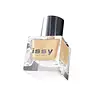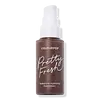What's inside
What's inside
 Key Ingredients
Key Ingredients

 Benefits
Benefits

 Concerns
Concerns

 Ingredients Side-by-side
Ingredients Side-by-side

Water
Skin ConditioningIsododecane
EmollientDimethicone
EmollientTrimethylsiloxysilicate
EmollientDiisopropyl Sebacate
EmollientButylene Glycol
HumectantAlcohol
AntimicrobialPEG-10 Dimethicone
Skin ConditioningLauryl PEG-8 Dimethicone
Perlite
AbsorbentSodium Hyaluronate
HumectantSodium Chloride
MaskingDisteardimonium Hectorite
StabilisingPanax Ginseng Root Extract
EmollientPhenoxyethanol
PreservativePolymethylsilsesquioxane
Hdi/Trimethylol Hexyllactone Crosspolymer
Mica
Cosmetic ColorantAluminum Hydroxide
EmollientSilica Dimethyl Silylate
EmollientCaprylyl Glycol
EmollientSodium Stearoyl Glutamate
CleansingTocopheryl Acetate
AntioxidantGlycerin
HumectantEthylhexylglycerin
Skin ConditioningPolyhydroxystearic Acid
EmulsifyingLecithin
EmollientCellulose Gum
Emulsion StabilisingIsopropyl Myristate
EmollientEthylhexyl Palmitate
EmollientIsostearic Acid
CleansingPolyglyceryl-3 Polyricinoleate
EmulsifyingTriethoxycaprylylsilane
Silica
AbrasiveCI 77891
Cosmetic ColorantCI 77491
Cosmetic ColorantCI 77492
Cosmetic ColorantCI 77499
Cosmetic ColorantWater, Isododecane, Dimethicone, Trimethylsiloxysilicate, Diisopropyl Sebacate, Butylene Glycol, Alcohol, PEG-10 Dimethicone, Lauryl PEG-8 Dimethicone, Perlite, Sodium Hyaluronate, Sodium Chloride, Disteardimonium Hectorite, Panax Ginseng Root Extract, Phenoxyethanol, Polymethylsilsesquioxane, Hdi/Trimethylol Hexyllactone Crosspolymer, Mica, Aluminum Hydroxide, Silica Dimethyl Silylate, Caprylyl Glycol, Sodium Stearoyl Glutamate, Tocopheryl Acetate, Glycerin, Ethylhexylglycerin, Polyhydroxystearic Acid, Lecithin, Cellulose Gum, Isopropyl Myristate, Ethylhexyl Palmitate, Isostearic Acid, Polyglyceryl-3 Polyricinoleate, Triethoxycaprylylsilane, Silica, CI 77891, CI 77491, CI 77492, CI 77499
Water
Skin ConditioningCyclopentasiloxane
EmollientIsopentyldiol
HumectantGlycerin
HumectantDiisopropyl Dimer Dilinoleate
EmollientPolymethylsilsesquioxane
Hdi/Trimethylol Hexyllactone Crosspolymer
PEG-10 Dimethicone
Skin ConditioningPolyglyceryl-6 Polyricinoleate
EmulsifyingDisteardimonium Hectorite
StabilisingSodium Chloride
MaskingCitrullus Lanatus Fruit Extract
Skin ConditioningSodium Hyaluronate
HumectantLens Esculenta Fruit Extract
Skin ConditioningCocos Nucifera Water
MaskingMalus Sylvestris Flower Extract
AntioxidantSodium Lactate
BufferingSodium PCA
HumectantCocos Nucifera Fruit Juice
EmollientPhenoxyethanol
PreservativeCaprylyl Glycol
EmollientAluminum Dimyristate
Emulsion StabilisingTriethoxycaprylylsilane
Potassium Sorbate
PreservativeDisodium Stearoyl Glutamate
CleansingBHT
AntioxidantTrisodium EDTA
Hexylene Glycol
EmulsifyingIron Oxides
CI 77891
Cosmetic ColorantWater, Cyclopentasiloxane, Isopentyldiol, Glycerin, Diisopropyl Dimer Dilinoleate, Polymethylsilsesquioxane, Hdi/Trimethylol Hexyllactone Crosspolymer, PEG-10 Dimethicone, Polyglyceryl-6 Polyricinoleate, Disteardimonium Hectorite, Sodium Chloride, Citrullus Lanatus Fruit Extract, Sodium Hyaluronate, Lens Esculenta Fruit Extract, Cocos Nucifera Water, Malus Sylvestris Flower Extract, Sodium Lactate, Sodium PCA, Cocos Nucifera Fruit Juice, Phenoxyethanol, Caprylyl Glycol, Aluminum Dimyristate, Triethoxycaprylylsilane, Potassium Sorbate, Disodium Stearoyl Glutamate, BHT, Trisodium EDTA, Hexylene Glycol, Iron Oxides, CI 77891
 Reviews
Reviews

Ingredients Explained
These ingredients are found in both products.
Ingredients higher up in an ingredient list are typically present in a larger amount.
Caprylyl Glycol is a humectant and emollient, meaning it attracts and preserves moisture.
It is a common ingredient in many products, especially those designed to hydrate skin. The primary benefits are retaining moisture, skin softening, and promoting a healthy skin barrier.
Though Caprylyl Glycol is an alcohol derived from fatty acids, it is not the kind that can dry out skin.
This ingredient is also used as a preservative to extend the life of products. It has slight antimicrobial properties.
Learn more about Caprylyl GlycolCi 77891 is a white pigment from Titanium dioxide. It is naturally found in minerals such as rutile and ilmenite.
It's main function is to add a white color to cosmetics. It can also be mixed with other colors to create different shades.
Ci 77891 is commonly found in sunscreens due to its ability to block UV rays.
Learn more about CI 77891Disteardimonium Hectorite comes from the clay mineral named hectorite. It is used to add thickness to a product.
It can also help stabilize a product by helping to disperse other ingredients.
Hectorite is a rare, white clay mineral.
Learn more about Disteardimonium HectoriteGlycerin is already naturally found in your skin. It helps moisturize and protect your skin.
A study from 2016 found glycerin to be more effective as a humectant than AHAs and hyaluronic acid.
As a humectant, it helps the skin stay hydrated by pulling moisture to your skin. The low molecular weight of glycerin allows it to pull moisture into the deeper layers of your skin.
Hydrated skin improves your skin barrier; Your skin barrier helps protect against irritants and bacteria.
Glycerin has also been found to have antimicrobial and antiviral properties. Due to these properties, glycerin is often used in wound and burn treatments.
In cosmetics, glycerin is usually derived from plants such as soybean or palm. However, it can also be sourced from animals, such as tallow or animal fat.
This ingredient is organic, colorless, odorless, and non-toxic.
Glycerin is the name for this ingredient in American English. British English uses Glycerol/Glycerine.
Learn more about GlycerinThis ingredient is a powder used to improve texture, slip, and give products a silky texture.
Peg-10 Dimethicone is silicone with conditioner and emulsifier properties. It mostly acts as an emollient in skincare and and humectant in haircare.
According to the manufacturer, acidic formulations decrease the stability of this ingredient. It works best in neutral or near neutral formulations.
Phenoxyethanol is a preservative that has germicide, antimicrobial, and aromatic properties. Studies show that phenoxyethanol can prevent microbial growth. By itself, it has a scent that is similar to that of a rose.
It's often used in formulations along with Caprylyl Glycol to preserve the shelf life of products.
Polymethylsilsesquioxane is a silicone used as a film forming agent.
When applied to the skin, this ingredient creates an invisible film on the surface. This film still allows oxygen to pass through, but prevents moisture from escaping. This can help condition and hydrate the skin. It also leaves a silky feel when applied.
Polymethylsilsesquioxane has not been shown to clog pores. It has been deemed safe to use up to 55%, but most cosmetics use much less.
If you have concerns about using this ingredient, we recommend speaking with a professional.
Learn more about PolymethylsilsesquioxaneChances are, you eat sodium chloride every day. Sodium Chloride is also known as table salt.
This ingredient has many purposes in skincare: thickener, emulsifier, and exfoliator.
You'll most likely find this ingredient in cleansers where it is used to create a gel-like texture. As an emulsifier, it also prevents ingredients from separating.
There is much debate on whether this ingredient is comedogenic. The short answer - comedogenic ratings don't tell the whole story. Learn more about comegodenic ratings here.
The concensus about this ingredient causing acne seems to be divided. Research is needed to understand if this ingredient does cause acne.
Scrubs may use salt as the primary exfoliating ingredient.
Learn more about Sodium ChlorideSodium Hyaluronate is hyaluronic acid's salt form. It is commonly derived from the sodium salt of hyaluronic acid.
Like hyaluronic acid, it is great at holding water and acts as a humectant. This makes it a great skin hydrating ingredient.
Sodium Hyaluronate is naturally occurring in our bodies and is mostly found in eye fluid and joints.
These are some other common types of Hyaluronic Acid:
Learn more about Sodium HyaluronateTriethoxycaprylylsilane is a silicone used to bind and stabilize ingredients.
As an emulsifier, it helps prevent ingredients from separating. This can help elongate the shelf life of products.
Triethoxycaprylylsilane is often used to coat mineral sunscreens ingredients to help give a better feel. It also helps reduce oxidative stress in sunscreens.
Learn more about TriethoxycaprylylsilaneWater. It's the most common cosmetic ingredient of all. You'll usually see it at the top of ingredient lists, meaning that it makes up the largest part of the product.
So why is it so popular? Water most often acts as a solvent - this means that it helps dissolve other ingredients into the formulation.
You'll also recognize water as that liquid we all need to stay alive. If you see this, drink a glass of water. Stay hydrated!
Learn more about Water